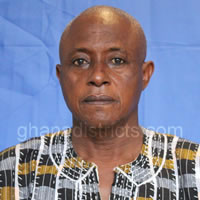Information and Communication Technology (ICT)
Use of ICT
The use of ICT is gradually gaining prominence in the municipal assembly especially for human resource management and recently the installation of the Ghana Integrated Financial Management Information System (GIFMIS) infrastructure. The assembly is however yet to take full advantage of ICT in its data management, revenue generation and investment promotion. The Assembly is in the process of opening its first ever website which is expected to be used to project and promote it to the outside world and business communities. The challenge to a complete roll-out of ICT infrastructure is the lack of reliable network. There is thus the need for government to support the assembly by linking the municipality to the roll-out of the fibre optic facility and construction of the e-governance telecommunication infrastructure to improve network access.
Ownership of Mobile Phones and Use of Internet
Cellular phone has formally become the most widely-used telecommunication tool in the Municipality and has been spreading faster than any telecommunication technology. About 79 percent of households own mobile phones in the Municipality. It was revealed that, 54.8 percent of males 12 years and older owned mobile phones whiles females recorded 46.2 percent. The Internet has become a very useful communication facility for people, businesses and organizations. Some of the common uses of the Internet include electronic mailing, accessing information, conducting business transactions, social networking and shopping. Again, 59.7 percent of all households headed by males have internet access whiles 40.3 percent of households headed by females could access internet in the municipality.
ICT and Education
The use of ICT in schools would have positive effects such as, acquisition of knowledge on any subject from the internet, promotion of electronic learning (that is Distance Learning) leading to acquisition of academic certificates and degrees at one’s own convenience. Some basic schools in the Municipality benefitted from the provision of laptops under the Government Policy of one (1) child one (1) laptop which was on pilot basis while almost all the second cycle schools have well equipped ICT laboratories. The promotion of ICT has helped students to check their BECE and WASCE results online, register for tertiary education, promotion of cultural exchange among others.
There are however challenges in the teaching of ICT in schools in the municipality. Some of which are; lack of adequate qualified trained ICT Teachers, lack of computers in schools together with computer laboratories, lack of electricity in many schools. There is therefore the need to invest in ICT training for teachers, setting up of computer laboratories in schools and connection of schools to electricity.
Telecommunication
Telecommunication services in the municipality have been developing over the years, especially with the introduction of the mobile phone net-works. Urban communities (including New Tafo, Kukurantumi, Old Tafo, Osiem etc) are currently connected to the national telecom grid, while other private telecommunication services have covered over 90% of the municipality.
Currently most communities have mobile commercial telephones. As per the 2010 PHC half (50.3%) of the population in the Municipality has access to mobile phones. Out of that total, a little more than half (51.9%) are males and 48.1 percent females. Almost ten years into the conduct of the last census, this figure has certainly improved significantly due to the excessive crave by Ghanaians for mobile phones and social media applications. This situation has drastically reduced extent of travel and physical contact within and outside the municipality.
Accessibility to Transportation Services
Road transport is by far the most important mode of transport in the municipality. The municipality has a fair distribution of accessible roads, majority of which link the Accra-Kumasi and Bunso-Koforidua trunk roads (Fig.1.11). Most people who live along these trunk roads have less travel time.
The conditions of feeder roads which form about 60% of the road network are generally poor. Most of the feeder roads have deteriorated, with some even unmotorable. Surface accessibility is therefore poor especially in the rainy season. Presently, the railway transport is not in operation in the municipality. This adversely affects easy movement of heavy goods and other services.
Road accidents continue to be a major source of bother to the Assembly. Most of the accidents occur on the major trunk road Bunso-Koforidua and mostly at night and during rainfall. The frequency of road accidents exerts undue pressure on the health centres especially the Hawa Memorial Hospital at Osiem which receives accidents victims from the main Accra-Kumasi highway.
Development Implications
There is the need to improve the road networks in the municipality especially to feeder road system that lead to most of the farms. This will facilitate the carting of farm produce and reduce the incidence of post-harvest losses.
Access to Health facilities
Health care delivery in the municipality is basically by the public sector with private participation. There are 3 hospitals, 2 private clinics and 2 private maternity homes. There are 8 structured CHPS and 10 non-structured CHPS or outreach clinics. Compounds with 2 maternity homes in the Municipality. Distribution of health facilities and personnel is however skewed in favour of the urban areas constituting about 70% of health facilities.
The availability of doctors in medical facilities across the municipality is an issue of serious concern in the midst of expanded healthcare infrastructure. With a high Doctor-to-Patients ratio the doctors in the municipality can be said to be overstressed and more efforts needs to be channeled in providing more staff accommodation to attract qualified doctors. The situation of nursing population has however improved marginally The spatial distribution of health facilities has been shown in Fig. 1.12.
Development Implications
Compared to the national average, number of health facilities and personal in the municipality could be said to be satisfactory. What needs to be done to improve health care delivery is to educate the populace on preventive health and ensure the provision of more CHPS to improve access to the rural communities.
Access to Extension Service
Agriculture is the main stay of the municipal economy registering over 58% of the labour force. Most of the farming activities are however at a small scale with the use of rudimentary implements and over reliance on the weather for water with its attendant low crop yield. The Municipal Department of Agriculture is responsible for the provision of agricultural extension services in the Municipality. It has a staff strength of 8 covering 12 operational areas.
This makes it very difficult to reach more farmers with more agricultural technologies in the Municipality. AEA-to-Farming Household Ratio is 1:580. Besides the large farmer population each AEA has to attend to, they also lack the requisite logistics including motor bikes, GPS, vehicle to facilitate their work. The lack of motor bikes in particular deprives most of the farmers in poor rural communities the services of extension officers. There is the need for more AEAs together with adequate logistics for the Government’s flagship project on Planting for Food and Jobs to succeed.
Development Implications
The need to improve upon extension service delivery through improved staffing and provision of the needed logistics cannot be overemphasized.
Scalogram Analysis
To identify the presence or absence of services and facilities within the Municipality, the settlement functional matrix (Scalogram analysis) was used. This is a non-statistical tool that arrays facilities and services by their ubiquity and ranks settlements by functional complexity on a matrix. By this, the settlements were ranked based on the different types of facilities in the settlements. This is presented in the settlement functional matrix or Scalogram analysis in Table.
The scalogram reveals that only New Tafo, the commercial capital, has a centrality index of more than 580 and form the 1st hierarchy or Level 1 settlement. The second and third hierarchy settlements in the Municipality are Kukurantumi (the capital) and Osiem with centrality indices ranging from 410 to 420 while Old Tafo occupies the 4th level settlement with centrality index slightly below 200.Anyinasin and Tontro occupy the 5th and 6th level settlement with centrality index of 113 and 104.2 respectively. All the others have centrality indices of below 100. The scalogram analysis shows that most of the settlements are within the low order centers lacking the capacity to serve their hinterlands. This calls for more service to be provided for most of the communities with low access to facilities and service.
Economic Infrastructure
The provision of adequate economic infrastructure is the surest way to boost local economic development. The municipality lags behind in terms of critical economic infructure including roads, electricity, telecommunication, markets and agro-processing facilities. The inadequate or absence of these facilities has slowed down the development of the local deconomy and a lot more work needs to be put in place to address the situation.
Road Network
The road network in the municipality is made up of about 100km feeder roads and 120km of urban roads. Data available indicates that over 80% of the feeder roads is not motorable especially during rainy seasons. The irony is that the feeder roads connect the farming communities to the market centers. As a result there is always high post-harvest losses annually thereby discouraging most farmers particularly the youth from venturing into farming or expanding existing ones.
Similarly, less than 20% of the urban road network is in good condition. This affects economic activities in the urban communities. Generally, the road infrastructure in the municipality needs to be improved if economic activities are to be promoted.
Post and Telecommunication
Postal and Telecommunication facilities have dwindled drastically in the municipality. Most of the postal agencies have either collapsed or under-utilized due to the advent of mobile telecommunication and internet connectivity coupled with the failure of the Postal Agencies to innovate to meet the modern trends. This notwithstanding, the available postal agencies run services like MoneyGram, EMS and other cash transfers alongside their traditional services.
In contrast, about 70% of communities in the municipality enjoy mobile telecommunication services even though in varied quality in reception depending on where one is located from the telecommunication mast. Telecommunication services are provided by all the major networks in the country, namely, MTN, Vodafone, Airtel, Tigo and Glo.
Energy
Electricity, LPG, charcoal and fuel wood are the main sources of energy in the municipality. LPG, charcoal and fuel wood are used for cooking and small scale industrial and commercial activities while electricity is used for lightning. There are a number of LPG supply point located at Kukurantumi and Tafo. There is therefore the need to encourage the private investors to invest in the sector in the remaining communities.
Electricity supply is largely significant with coverage of 100% in respect of the 16 main communities in the municipality even though there a several suburbs which are yet to be connected to the national grid. A situation which needs to be addressed if the agenda for boosting agro-processing is to be materialized. It is equally worthy of note that majority of the newly developed sites in both urban and rural areas are without electricity supply. The assembly should thus make the procurement and supply of high and low tension poles a priority in the plan period. It is also important to seek the advice of the ECG before procuring the poles in order to avoid their rejection for reason of specifications.
Housing
Housing is one of the major necessities of life and for that matter its provision has always been recognized as imperative in improving the living conditions of people. However, provision of housing facilities without healthy sanitary and environmental conditions has a negative impact on both economic and social development of the municipality. The availability of housing facilities such as access to adequate sanitary facilities, safe water supplies and drainage systems are essential requirements for enhancing the health status of men, women and children. The focus of the analysis is on housing stock, type of dwelling, room occupancy, holding and tenancy, lighting and cooking facilities.
Housing Stock
The municipality has an approximate number of 18,000,201 houses for a total population of 98008 accounting for an average of 5.2 persons per house. There are 25,130 households giving an average household size of 3.9 with an average household per house being 1.5 for the municipality, 1.3 for rural and1.7 for urban areas. The rural areas’ share of the municipality’s housing stock is 45% as against 55% for the urban area.
Type of dwelling units
There are three most common types of dwelling units; compound house, separate house, and semi-detached house in the municipality. Compound houses constitute (62.4%), followed by separate houses (26.8%) and semi-detached houses (6.2%). Other dwelling units in popular use are flats and apartments (2.0%) and Huts/buildings (1.4%). Each of the other categories of dwelling units accounts for less than one percent of dwelling units in the municipality.
In terms of types of household heads, 66.8% of dwelling units with female heads are compound houses, followed by separate houses (23.3%), and Semi-detached houses (6.1%). In the case of male headed households, compound houses constitute 59.7% followed by separate houses (29.0%) and Semi-detached houses (6.3%). Data again shows that the proportion of dwellings units that are compound houses is higher in the urban (67.1%) areas than rural areas (54.9%). On other hand, separate house is more common in rural areas (35.1%) than in urban areas (21.5%).
Construction Materials
According the PHC of 2010, cement blocks/concrete and mud brick/earth are the two main construction materials used by households for outer walls in the municipality. Of the two construction materials, cement blocks/concrete accounts for 65.7% of all types of materials used for wall construction followed by mud brick/earth (24.9%). The use of cement blocks/concrete features most prominently in wall construction in the urban localities (77.6%) while rural localities mostly use mud brick/earth (48.1%) of wall materials.
Access to utilities and household facilities
Nature of the source of lighting is one of the indicators of quality of life. Table 1.55 shows that the three main sources of light for households in the municipality are electricity which accounts for 67.2%, followed by kerosene (26.7%) and flashlight/torch (4.1%). Access to electricity is however above the regional average of 58.5%. The urban localities have a higher proportion of electricity of 72.8% while rural localities dominate in the use of kerosene (34.3%). The rural electricity coverage of about 60% is still inadequate and needs to be improved if the assembly’s plans to establish more agro-processing industries in the rural areas is to be materialized. More rural communities need to be connected to the national grid within the plan period.
Date Created : 3/22/2019 6:38:07 AM






 facebook
facebook X (twitter)
X (twitter) Youtube
Youtube +233 593 831 280
+233 593 831 280 0800 430 430
0800 430 430 GPS: GE-231-4383
GPS: GE-231-4383 info@ghanadistricts.com
info@ghanadistricts.com Box GP1044, Accra, Ghana
Box GP1044, Accra, Ghana